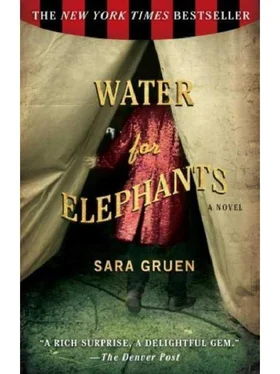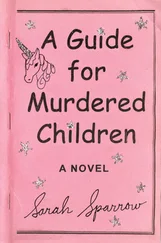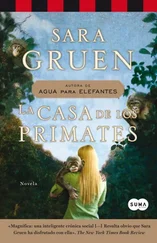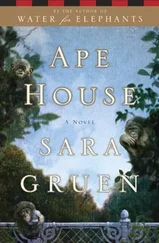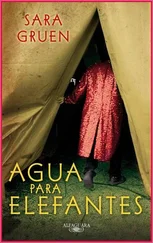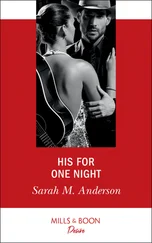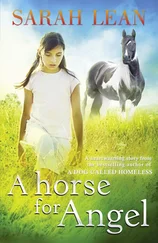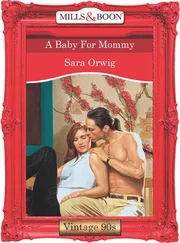Sara Gruen - Water for Elephants
Здесь есть возможность читать онлайн «Sara Gruen - Water for Elephants» весь текст электронной книги совершенно бесплатно (целиком полную версию без сокращений). В некоторых случаях можно слушать аудио, скачать через торрент в формате fb2 и присутствует краткое содержание. Жанр: Природа и животные, на английском языке. Описание произведения, (предисловие) а так же отзывы посетителей доступны на портале библиотеки ЛибКат.
- Название:Water for Elephants
- Автор:
- Жанр:
- Год:неизвестен
- ISBN:нет данных
- Рейтинг книги:5 / 5. Голосов: 1
-
Избранное:Добавить в избранное
- Отзывы:
-
Ваша оценка:
- 100
- 1
- 2
- 3
- 4
- 5
Water for Elephants: краткое содержание, описание и аннотация
Предлагаем к чтению аннотацию, описание, краткое содержание или предисловие (зависит от того, что написал сам автор книги «Water for Elephants»). Если вы не нашли необходимую информацию о книге — напишите в комментариях, мы постараемся отыскать её.
Water for Elephants — читать онлайн бесплатно полную книгу (весь текст) целиком
Ниже представлен текст книги, разбитый по страницам. Система сохранения места последней прочитанной страницы, позволяет с удобством читать онлайн бесплатно книгу «Water for Elephants», без необходимости каждый раз заново искать на чём Вы остановились. Поставьте закладку, и сможете в любой момент перейти на страницу, на которой закончили чтение.
Интервал:
Закладка:
“All right,” he says.
“All right?”
“All right. Let’s give you something to tell your grandkids about. Or great-grandkids. Or great-great-grandkids.”
I snort with glee, delirious with excitement. Charlie winks and pours me another finger’s worth of whiskey. Then, on second thought, he tips the bottle again.
I reach out and grab its neck. “Better not,” I say. “Don’t want to get tipsy and break a hip.”
And then I laugh, because it’s so ridiculous and so gorgeous and it’s all I can do to not melt into a fit of giggles. So what if I’m ninety-three? So what if I’m ancient and cranky and my body’s a wreck? If they’re willing to accept me and my guilty conscience, why the hell shouldn’t I run away with the circus?
It’s like Charlie told the cop. For this old man, this is home.
The idea for this book came unexpectedly: In early 2003 I was gearing up to write an entirely different book when the Chicago Tribune ran an article on Edward J. Kelty, a photographer who followed traveling circuses around America in the 1920s and ’30s. The photograph that accompanied the article so fascinated me that I bought two books of old-time circus photographs: Step Right This Way: The Photographs of Edward J. Kelty and Wild, Weird, and Wonderful: The American Circus as Seen by F. W. Glasier . By the time I’d thumbed through them, I was hooked. I abandoned the book I’d planned to write and dove instead into the world of the train circus.
I started by getting a bibliography of suggested reading from the archivist at Circus World, in Baraboo, Wisconsin, which is the original winter quarters of the Ringling Brothers. Many of the books were out of print, but I managed to get them through rare booksellers. Within weeks I was off to Sarasota, Florida, to visit the Ringling Circus Museum, which happened to be selling off duplicates of books in its rare book collection. I came home poorer by several hundred dollars and richer by more books than I could carry.
I spent the next four and a half months acquiring the knowledge necessary to do justice to this subject, including taking three additional research trips (a return to Sarasota, a visit to Circus World in Baraboo, and a weekend trip to the Kansas City Zoo with one of its former elephant handlers to learn about elephant body language and behavior).
The history of the American circus is so rich that I plucked many of this story’s most outrageous details from fact or anecdote (in circus history, the line between the two is famously blurred). These include the display of a hippo pickled in formaldehyde, a deceased four-hundred-pound “strong lady” being paraded around town in an elephant cage, an elephant who repeatedly pulled her stake and stole the lemonade, another elephant who ran off and was retrieved from a backyard vegetable patch, a lion and a dishwasher wedged together under a sink, a general manager who was murdered and his body rolled up in the big top, and so on. I also incorporated the horrific and very real tragedy of Jamaica ginger paralysis, which devastated the lives of approximately one hundred thousand Americans between 1930 and 1931.
And finally, I’d like to draw attention to two old-time circus elephants, not just because they inspired major plot points, but also because these old girls deserve to be remembered.
In 1903 an elephant named Topsy killed her trainer after he fed her a lit cigarette. Most circus elephants at the time were forgiven a killing or two—as long as they didn’t kill a rube—but this was Topsy’s third strike. Topsy’s owners at Coney Island’s Luna Park decided to turn her execution into a public spectacle, but the announcement that they were going to hang her met with uproar—after all, wasn’t hanging a cruel and unusual punishment? Ever resourceful, Topsy’s owners contacted Thomas Edison. For years, Edison had been “proving” the dangers of rival George Westinghouse’s alternating current by publicly electrocuting stray dogs and cats, along with the occasional horse or cow—but nothing as ambitious as an elephant. He accepted the challenge. Because the electric chair had replaced the gallows as New York’s official method of execution, the protests stopped.
Accounts differ as to whether Topsy was fed cyanide-laced carrots in an early, failed, execution attempt or whether she ate them immediately before she was electrocuted, but what is not disputed is that Edison brought a movie camera, had Topsy strapped into copper-lined sandals, and shot sixty-six hundred volts through her in front of fifteen hundred spectators, killing her in about ten seconds. Edison, convinced that this feat discredited alternating current, went on to show the film to audiences across the country.
On to a less sobering note. Also in 1903, an outfit in Dallas acquired an elephant named Old Mom from Carl Hagenbeck, a circus legend who declared her to be the smartest elephant he’d ever had. Their hopes thus raised, Old Mom’s new trainers were dismayed to find they could persuade her to do nothing more than shuffle around. Indeed, she was so useless she “had to be pushed and pulled from one circus lot to another.” When Hagenbeck later visited Old Mom at her new home, he was aggrieved to hear her described as stupid and said so—in German. It suddenly dawned on everyone that Old Mom only understood German. After this watershed, Old Mom was retrained in English and went on to an illustrious career. She died in 1933 at the ripe old age of eighty, surrounded by her friends and fellow troupers.
Here’s to Topsy and Old Mom—
A Conversation with the Author 339
Book-Group Discussion Questions 347


Dave Weich is director of marketing and development at Powell’s Books. This conversation first appeared, in different form, online at Powells.com. © 2006 Powells.com. Reprinted by permission.
Dave Weich:Is it true that you’d never been to a circus before starting your research for Water for Elephants?
Sara Gruen:It’s true. I had no history whatsoever. No interest, no connection to anyone associated with the circus. I grew up in northern Ontario. I don’t know if they didn’t come up that far or if I just never went, but if I did go it made such a little impression on me that I didn’t remember it.
DW:What wound up being your favorite act?
SG:In the end, the liberty horses.
DW:Describe exactly what they do.
SG:A person, usually a beautiful woman, comes out with a group of twelve horses typically, sometimes all white, sometimes black and white. She stands and makes signals with whips in the air, and she talks to them, and they obey her.
I have a horse, and I think it’s very cool that they can get horses doing that with no restraint and no halter.
DW:Marlena is that woman in Water for Elephants .
SG:Yes, and in fact I modeled her act after ones I had watched.
DW:You explain in a note after the final chapter that many of the details in the novel were drawn from real life, or what passes for it in existing records. For instance, one of the strangest: the scared lion hiding under a sink.
SG:It’s true.
DW:And Rosie was based on a real elephant?
Читать дальшеИнтервал:
Закладка:
Похожие книги на «Water for Elephants»
Представляем Вашему вниманию похожие книги на «Water for Elephants» списком для выбора. Мы отобрали схожую по названию и смыслу литературу в надежде предоставить читателям больше вариантов отыскать новые, интересные, ещё непрочитанные произведения.
Обсуждение, отзывы о книге «Water for Elephants» и просто собственные мнения читателей. Оставьте ваши комментарии, напишите, что Вы думаете о произведении, его смысле или главных героях. Укажите что конкретно понравилось, а что нет, и почему Вы так считаете.
